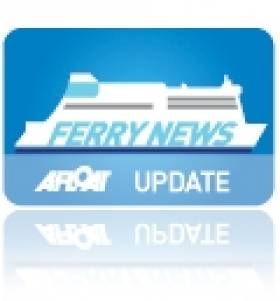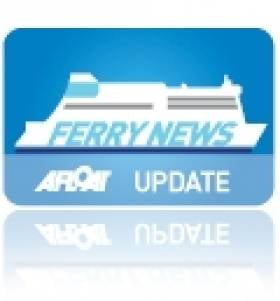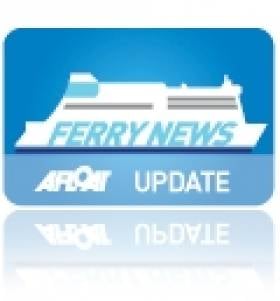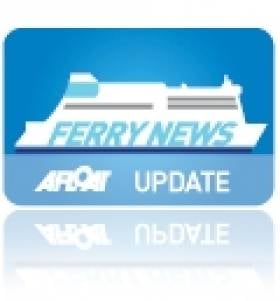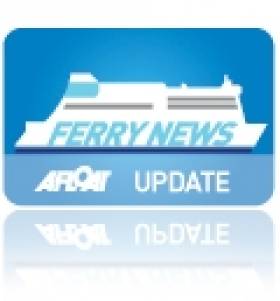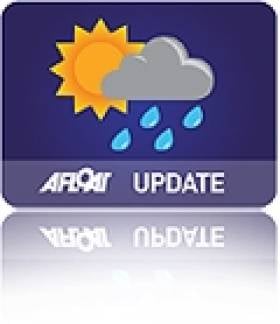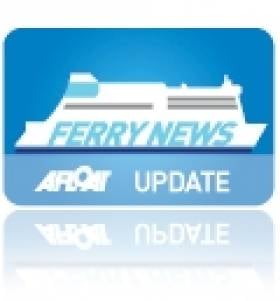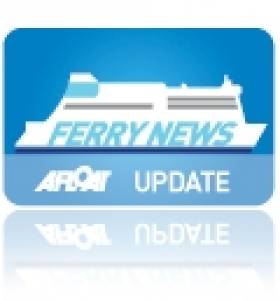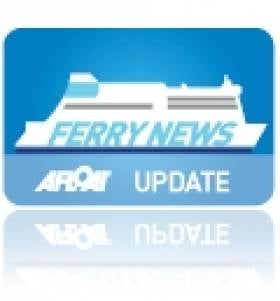Displaying items by tag: Irish Ferries
French Routes Rivals Vie for Market-Share
#FERRY NEWS- Established ferry operators on routes to France are gearing –up for market share with the first battle for 2012 targeting the Spring Easter period, with recent T.V. advert campaigns launched by Irish Ferries and Brittany Ferries, writes Jehan Ashmore.
Last week Irish Ferries reopened Rosslare-Cherbourg sailings by the cruiseferry Oscar Wilde (1987/31,914grt). The largest ever vessel to serve Irish Ferries French routes will also resume high-season sailings to Roscoff in May. For sailing times of both routes click HERE.
Brittany Ferries will embark their season with Cork-Roscoff sailings on 31st March with 'flagship' Pont-Aven (2004/41,748grt). This route operates a single weekend round-trip schedule, with arrivals and departures to Cork each Saturday, for more on sailings click HERE.
While Celtic Link Ferries, which entered the continental sector in 2005 having taken over from P&O (Irish Sea) introduced a new vessel on the Rosslare-Cherbourg route last October with the chartered ro-pax Celtic Horizon (2006/27,522grt) as previously reported on Afloat.ie.
Unlike their rivals, Celtic Link Ferries are the only operator to maintain year-round sailings in this sector, for schedule click HERE.
Irish Ferries 'Flagship' Returns to Dublin Route
#FERRIES - Ulysses arrived fresh from refit on the Dublin-Holyhead route yesterday after annual dry-docking at Cammell Laird, Birkenhead, writes Jehan Ashmore.
As previously reported on Alfoat.ie the Irish Ferries 'flagship' sailings on the central corridor route (also served by Jonathan Swift) where relieved by Isle of Inishmore earlier this month.
Isle of Inishmore departed Dublin Port last evening and headed to Liverpool Bay, where she anchored overnight. She docked at Cammell Laird this afternoon, where she too is to undergo annual overhaul.
With Isle of Inishmore off service on her usual Rosslare-Pembroke Dock route, the company's French routes vessel, Oscar Wilde is maintaining sailings.
On 19th February, the Oscar Wilde resumes service on Rosslare-Cherbourg route and she will also re-open the seasonal-only operated route to Roscoff which starts in May.
Bad Weather Continues to Disrupt Ferry Sailings
#FERRIES - As the adverse weather continues, ferry services across the Irish Sea remain affected, with several crossings cancelled, writes Jehan Ashmore.
Irish Ferries 08.05hrs sailing this morning from Dublin to Holyhead operated by Isle of Inishmore, departed over three hours later than her scheduled time.
Last night she had just been deployed on the route so to cover sailings usually operated by Ulysses, which went off-service for annual dry-docking at Cammell Laird, Birkenhead, as previously reported on Afloat.ie
In addition the fast-ferry craft sailing at 08.45hrs from Dublin Port served by the Jonathan Swift were cancelled and the following sailings are also cancelled:
Dublin -Holyhead 14.30hrs
Holyhead-Dublin 12.00hrs AND 17.15hrs
Passengers booked on the Jonathan Swift instead will be accommodated on the Isle of Inishmore. For further information on Dublin-Holyhead sailing updates click HERE.
On the Rosslare-Pembroke Dock service, sailings were too cancelled with last night's sailing from Wales, which are currently served by Oscar Wilde. She sailed as scheduled with this morning's 08.45hrs sailing to Pembroke Dock.
To keep updated on Rosslare-Pembroke Dock sailings click HERE.
For further information, Irish Ferries Central Reservations contact: 0818 300 400 and for Irish Ferries, Rosslare Harbour contact: 00353 53 9133158
STENA LINE
For information on sailing schedules and updates from the company's Ferrycheck facility click HERE.
To contact Stena Line call: 003531 204 77 99 when travelling to Britain or 0044 (0) 8705 755 755 when travelling to Ireland or Scotland
P&O FERRIES
Dublin to Liverpool sailing at 1500hrs is cancelled and passengers will be accommodated on either 2130hrs tonight or 0900hrs on Friday 6th January.
For other sailings and on the Larne-Cairnryan click HERE and to contact +44 (0) 871 66 44 777 if calling from UK
OR (01) 407 34 34 if calling from ROI. In addition to latest sailing infomation on +44 (0)845 832 8888
FOR OTHER FERRY OPERATORS
Please click this LINK and choose the relevant highlighted ferry route for further information.
Dublin Route Reduced to Single-Ship Service
#FERRIES – Stena Line's two-ship operated Dublin-Holyhead route is to be reduced to a single vessel service as from tomorrow, due to annual dry-docking requirements, writes Jehan Ashmore.
Stena Nordica (2000/24,206grt) is to go off the route for a refit from 5th-19th January. The last sailing scheduled for the ferry will be from Dublin Port at 02.15hrs on 5th January. She is scheduled to return on the 3 hour 15 minute route on 19th January with the 16.00hrs sailing from the capital.
Fleetmate Stena Adventurer will continue operating to her normal schedule while the Japanese ro-pax vessel is away for the dry-docking period. For information on route sailings schedules click HERE.
During the off-peak winter season, particularly during the months of January and February, it is common practice for ferry operators to take vessels off-service for annual dry-docking.
In addition to Stena Line, rivals Irish Ferries today started a fleet logistic operation as vessels are taken off and on routes for dry-docking and replaced with temporary tonnage, as previously reported on afloat.ie
Ferry Go-Round
# FERRY NEWS - Irish Ferries French routes cruiseferry Oscar Wilde (1987/31,914grt) took over Rosslare-Pembroke Dock sailings with this morning's sailing, instead of the usual route vessel that operates on the southern corridor route, writes Jehan Ashmore.
Currently there are no services running to Cherbourg until February, though Oscar Wilde is covering in for the Welsh route ferry Isle of Inishmore (1997/31,031grt). She in turn is due to relief Dublin-Holyhead sailings from tonight on the route which is normally served by flagship Ulysses (2001/50,938grt) which heads off for dry-docking.
In the meantime Isle of Inishmore is in Rosslare after completing last night's sailing from the Pembrokeshire port. She is due to make a repositioning voyage with an arrival into Dublin Port this evening and followed by a brief turn-around at the ferryport, she is take over the route's roster with tonight's 20.55 crossing to Holyhead.
Ireland Battered by Storm-Force Winds
#WEATHER - Ireland has been warned to brace for further strong winds set to sweep across the country today (4 January),
The Irish Times reports. Winds reaching near hurricane speeds have affected coastal communities in the north and northwest, peaking at a remarkable 168km/h in Donegal.
Thousands of euro worth of damage was caused when the roofs of traditional thatched cottages at Cruit Island in west Donegal were blown away.
But the west and east have also been hard hit, with storm-force gales exceeding 100km/h uprooting trees and disrupting electricity supply.
As previously reported on Afloat.ie, ferry services on the east coast have been severely affected. Irish Ferries cancelled two fast ferries from Dublin to Holyhead yesterday, and today's early Jonathan Swift sailings between Dublin and Holyhead were also cancelled.
Met Éireann expects wind speeds to be lower today, but could still reach 90-120km/h in some areas.
The Irish Times has much more on the story HERE.
Severe Weather Disrupts Ferry Services
#FERRY NEWS – With travel disruption to some Irish Sea ferry services due to the severe weather conditions battering across the country, the following ferry operator's website links below provide the latest sailing schedules and contact details.
It is also advisable to contact the ferry operator to inquire about the port check-in time prior to setting off. For further information click over each of the route as highlighted below.
In addition to keep abreast of weather warning updates click www.met.ie/ and www.metoffice.gov.uk/
IRISH FERRIES
Central Reservations Tel: 0818 300 400 OR
Rosslare Tel: (053) 9133158
Rosslare-Cherbourg: Sailings have been temporarily suspended due to annual dry-docking of the cruiseferry Oscar Wilde. Sailings resume with the first departure in 2012 from Rosslare on 19th February and the corresponding return sailing from Cherbourg is scheduled for 21st February. For timetable click HERE.
STENA LINE
Tel: (01) 204 77 99 when travelling to Britain OR
Tel: 00 44 (0) 8705 755 755 when travelling to Ireland or Scotland.
Dun Laoghaire-Holyhead Note: the high-speed (HSS) route remains suspended until April or May 2012.
Belfast-Liverpool (Birkenhead)
P&O Ferries
Tel: 00 353 (0)1 407 3434
Larne-Troon. Note: the 'Express' fast-ferry craft operated route is due to re-open in March 2012.
KINTYRE EXPRESS
Tel: 00 44 1586 555 895
Note: FOOT-PASSENGER ONLY fast-RIB craft service which is currently operating to a winter service (October 2011-April 2012) which runs only on Friday's and Monday's.
CELTIC LINK FERRIES
Tel: (053) 916 2688
FASTNET LINE
Tel: (021) 437 8892 OR UK 00 44 (0) 844 576 8831
Note: The Celtic Sea route is due to re-open on 6th April 2012 with a sailing from Swansea.
Former B+I Line Freight-Ferry Bound for Turkish Breakers
#FERRY NEWS-P&O Irish Sea's Larne-Troon freight-ferry Norcape (14,087grt) departed the Co. Antrim port last week to be broken-up at ship-breakers in Aliaga, Turkey. She originally served B+I Line as the Tipperary, but her last sailings took place on the North Channel in late November, as the ageing vessel is in her fourth decade of service, writes Jehan Ashmore.
The 125-trailer capacity ro-ro was not replaced on the single-ship operated route which closed for the winter months, though sailings will resume next March by the 92m fast-ferry Express. In the meantime freight traffic will be accommodated on the companies Larne-Cairnryan service.
Yesterday morning Norcape transitted the Strait of Gibraltar having called en-route to Falmouth several days previously. She represented the last vessel to serve in Irish waters with a direct link to B+I Line, the state-owned operator which was sold in 1992 to ICG, parent company of Irish Ferries.
When she arrives in Aliagra, this is where her former P&O fleetmate European Mariner (5,897grt) was scrapped after also serving Larne-Troon sailings until last July. Norcape entered the North Channel route replacing the smaller 53-trailer capacity vessel.
Prior to then Norcape had been in laid-over in Liverpool docks when European Endeavour replaced her in February on the Dublin-Liverpool route. To read more click HERE.
Norcape's return to the Irish Sea service in 2009, reflected her original career for P&O. She was named Puma in 1979 from the Japanese shipyard at the Mitsui Engineering & SB Co Ltd, Tamano, however she was chartered to B+I Line and renamed Tipperary. To read more and to view a deck-drawing profile, click HERE.
Her career started with a new Dublin-Fleetwood route jointly operated with P&O, who contributed with a sister, the Ibex. The P&O brand name Pandoro stood for P and O Ro, their roll-on roll-off freight division. The route's UK port switched to Liverpool in 1988 with Tipperary remaining on the route until sold to North Sea Ferries in 1989 and renamed Norcape.
Before her transfer to the North Sea, Tipperary collided with the 4,674grt bulker Sumburgh Head off the entrance to Dublin Port in 1988. Incidentally the two vessels, under different names and ownership were in Dublin Port in 2010, as previously reported (with photo) click HERE.
- Ports and Shipping News
- Norcape
- P&O (Irish Sea)
- B+I Line
- European Endeavour
- Ferry news
- Irish Sea Ferries
- Irish Sea ferry news
- LarneTroon
- MV Tipperary
- Turkish shipbreakers
- P&O Express
- MV Ibex
- Pandoro
- Aliagra,Turkey
- MV Norcape
- ICG
- ICG Group
- Irish Continental Line
- North Channel ferry routes
- LarneCairnryan
- Irish Ferries
Scottish Ferry Sailings Suffer Storm Disruption
#FERRY NEWS - With winds of up to 100mph, Scottish ferry sailings on the North Channel routes from Northern Ireland, have been affected with two cancellations on Stena's Belfast-Cairnryan services, according to Channel 4 News.
P&O had no reported cancellations on its Irish Sea routes but is advising passengers to check in normally and expect delays. In addition some Scottish domestic ferry services were cancelled on some routes operated by Caledonian MacBrayne, while other services were disrupted.
To read more about the weather disruption across the Scottish central belt remains which remains on-high alert for storms while Northern Ireland and the north of England are subject to a severe weather warning click HERE. For the latest weather visit www.metoffice.gov.uk/
Sailing updates from Stena Line's Belfast-Cairnryan service can be viewed by clicking HERE and for information on delays on Belfast-Liverpool service click HERE. For sailing updates on routes operated by P&O click this LINK.
For the rest of the Irish Sea ferry routes, including those operated by Stena Line and Irish Ferries it would be also advisable to check each route from the operator's websites.
Irish Ferries Dublin Swift fast-ferry sailings to and from Holyhead have been cancelled, though cruiseferry sailings remain operating. To keep updated visit the 24hrs sailing update posted on the homepage of www.irishferries.com and for Irish weather coverage by visiting www.met.ie
Irish Ferries Win Best Ferry Company
#FERRY NEWS- Irish Ferries has won the 'Best Ferry Company' award at the Irish Travel Agents Association travel industry awards held last night in the Mansion House, Dublin.
This was the thirteenth time that the award has gone to Irish Ferries since the event started two decades ago. The award which was presented on foot of votes cast by travel agents and their staff employed throughout the island of Ireland was accepted jointly by its head of passenger sales Declan Mescall and passenger sales manager Marie McCarthy.
Thanking travel agents for the honour their decision bestows on the company, Mr. Mescall said that the Best Ferry award reflects the high standard of service which passengers can now expect from Irish Ferries.
'In addition, it recognises the numerous developments that have taken place in the company in recent times, including the introduction of class leading advances in electronic communications, the most recent being the introduction of the industry's first bookable smart phone app which was launched just months ago' said Mr. Mescall.
The award follows Irish Ferries parent company Irish Continental Group (ICG) whose Dutch based container division Eucon Shipping and Transport was awarded Short Sea Shipping Company of the Year Award 2011, sponsored by the Irish Maritime Development Office (IMDO).
Eucon operate regular feeder services to Antwerp, Rotterdam and Southampton from the ports of Belfast, Dublin and Cork.


























